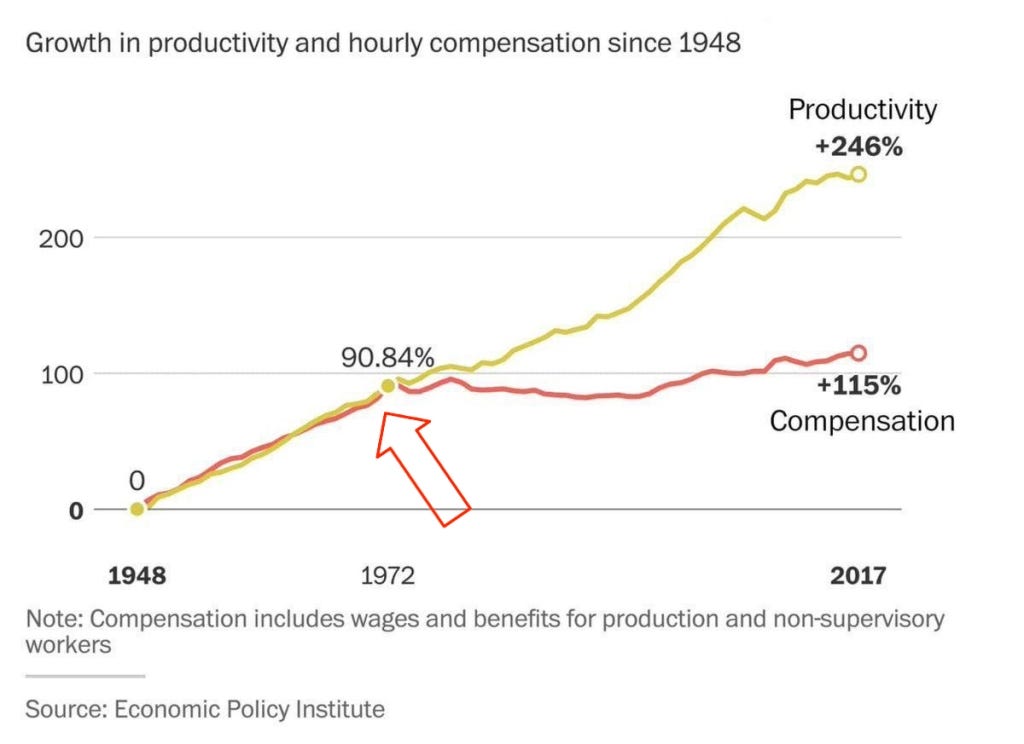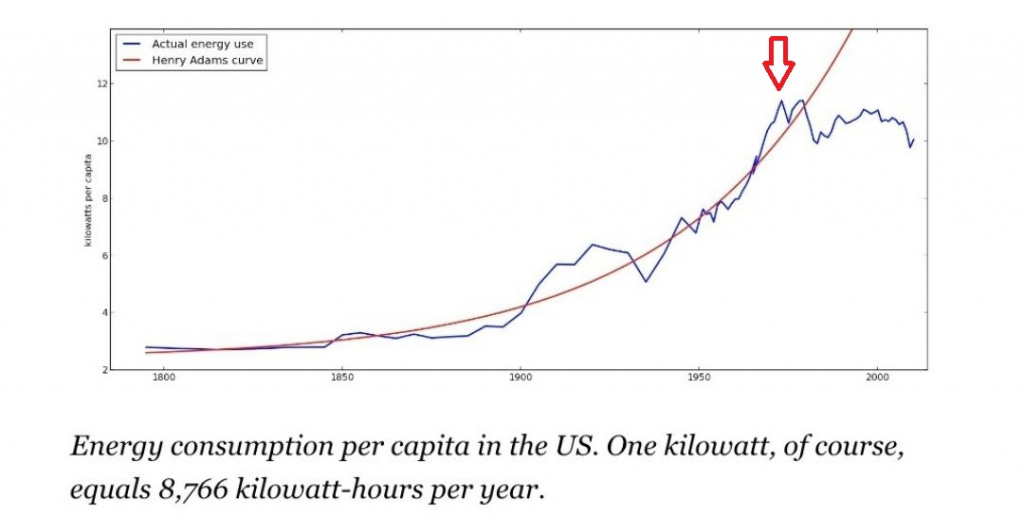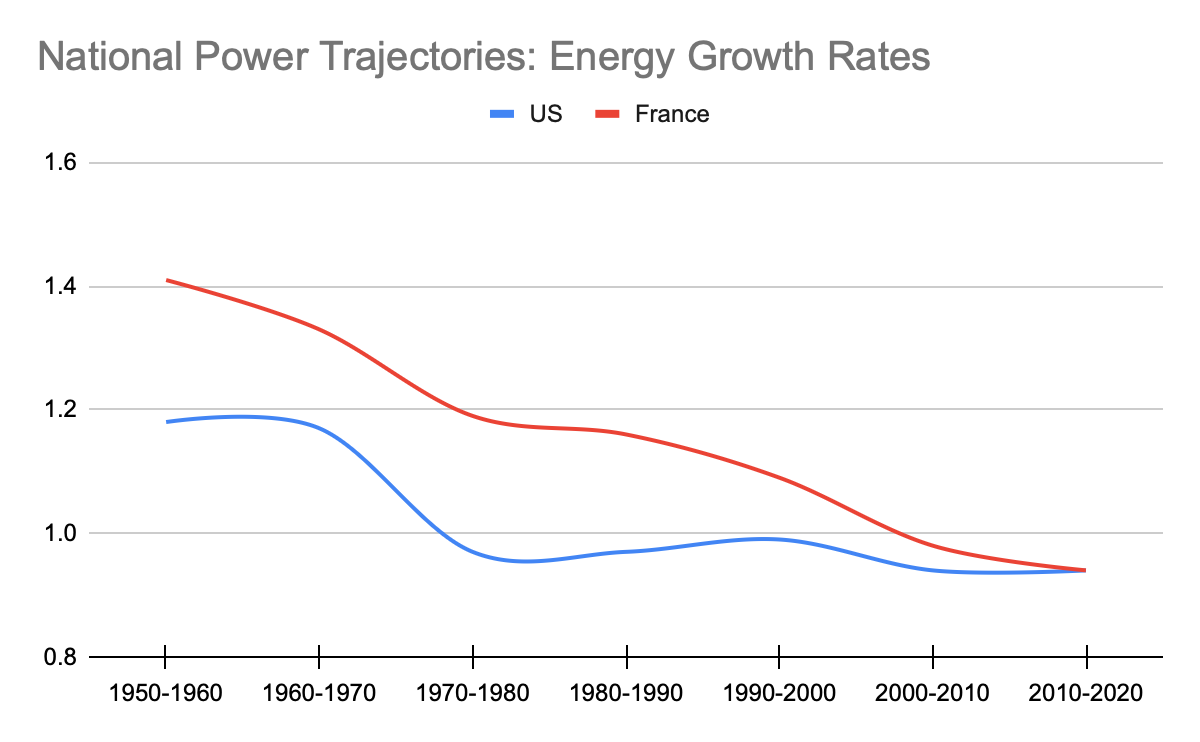Every economics textbook tells the same story: Our era is defined by the triumph of information technology and ideas over physical constraints. The shift from manufacturing to services represents inevitable progress, they say. America evolved beyond the industrial age.
But what if this entire narrative is backwards?
In 1971, something broke in America. Real wages peaked and never recovered. Manufacturing began its steady decline. Infrastructure investment collapsed. While many blame the abandonment of the gold standard, there was a far more consequential shift: America began rationing energy.
This wasn't evolution – it was adaptation to constraint. Restricted by power limits, we pivoted to innovate in bits rather than atoms. We rebranded our manufacturing exodus as "post-industrial progress" rather than what it really was: a strategic retreat from the physical world.
I call this "Power State Theory" – the idea that energy availability fundamentally shapes the paths of innovation. This theory explains both America's digital pivot and why our software revolution is now hitting its inherent limits.
To build a truly prosperous future, we must first confront an uncomfortable truth: America's digital revolution wasn't a triumph of progress, but a clever adaptation to artificial constraint. And now those constraints are catching up with us.
When America Entered Low Power Mode
In 1971, America hit pause. As oil prices spiked, we made a decision that would reshape the next fifty years: we chose to ration energy rather than expand production.
Most people have never heard of the Henry Adams curve. But this curve is as fundamental to understanding progress as Moore's Law is to computing. Adams observed something remarkable: humanity's power output doubled every decade from 1840 to 1900. Each exponential leap enabled new infrastructure, new industries, new possibilities.
Then in 1971, America fell off the curve.
For the first time in modern history, our energy consumption per capita flatlined. Instead of confronting this constraint, we found a clever escape hatch: we redirected America's innovative capacity toward digital technologies—where progress demanded fewer watts.
The divergence between our physical and digital worlds became so stark it's almost comical:
In 1973, the Concorde flew passengers at Mach 2. Today, our commercial planes fly slower than they did 50 years ago
In 1969, we put humans on the moon. Today, NASA struggles to repeat what it achieved with slide rules and punch cards
In 1958, we built the 46,000-mile Interstate Highway System in just 35 years. Today, California can't complete a 119-mile high-speed rail line after 15 years of trying
Meanwhile, our digital technology advances at warp speed. We carry supercomputers in our pockets. AI writes essays and generates art. Computing power doubles every two years like clockwork.
This wasn't random. It was the predictable adaptation of a High Power State transitioning to Low Power Mode. To understand why, we need a new framework for thinking about energy and innovation.
Power State Theory: A New Economic Framework
The deeper I studied America's digital pivot, the more a fundamental pattern emerged. Nations exist in one of two states: High Power or Low Power. The transition between these states doesn't just affect energy consumption—it completely redirects how a society innovates.
I call this "Power State Theory." At its core, we can express a nation's Power State (PS) mathematically:
Where:
E = Available energy per capita
E_t = Threshold energy level needed for advanced industrial activity
When a nation has abundant, affordable energy (High Power State), it innovates everywhere—from massive infrastructure projects to microprocessors. But when energy becomes constrained (Low Power State), innovation gets redirected toward domains that can create value with minimal power input.
This redirection follows what I call the Innovation Allocation Rule: talent and capital flow to wherever they can create value within energy constraints. Like water finding the path of least resistance, a nation's innovative capacity gets channeled into increasingly narrow domains as its Power State declines.
This simple rule explains both America's spectacular digital success and our simultaneous physical stagnation.
The European Energy Experiment: A Tale of Two Paths
We don't have to speculate about Power State Theory. Europe ran the experiment for us.
While America retreated from nuclear power after the 1970s energy crisis, two industrial powerhouses—France and Germany—made radically different energy choices. Their diverging outcomes tell us everything we need to know about the relationship between energy and innovation.
France's Nuclear Commitment When the oil crisis hit, France didn't flinch. They launched the ambitious "Messmer Plan" in 1974, building 56 nuclear reactors that now provide over 70% of their electricity. The results were precisely what Power State Theory would predict:
France maintained a higher manufacturing percentage of GDP through the 1980s and 1990s
They built an extensive high-speed rail network while America's passenger rail stagnated
They preserved strong positions in energy-intensive industries like chemicals, metals, and glass manufacturing
France's Power State Index remained above the critical 1.0 threshold long after America dipped into "low power mode."
But when France eventually slowed their nuclear expansion and began prematurely retiring plants, their manufacturing base began experiencing the same decline as the United States—perfectly aligned with their transition back toward a Low Power State.
Germany's Four-Act Energy Drama Across the Rhine, Germany has unwittingly staged the perfect demonstration of Power State Theory—a drama in four acts that shows exactly what happens when a nation's Power State rises and falls.
Act 1: Nuclear Expansion (1975-2000) Germany builds 19 nuclear plants, watches its Power State Index climb, and cements its position as Europe's industrial powerhouse.
Act 2: The Golden Years (2000-2011) With abundant energy flowing, Germany maintains its manufacturing dominance. Their Power State Index stays high, and their factories keep humming.
Act 3: The Energiewende Gamble (2011-2022) After Fukushima, Germany makes a fateful choice: phase out nuclear while betting big on Russian gas and renewables. Despite pouring billions into wind and solar, industrial electricity prices soar. The results match Power State Theory perfectly: energy-intensive industries start to crack while precision manufacturing holds steady.
Act 4: The Energy Curtain Falls (2022-2023) Russia's invasion of Ukraine delivers the ultimate stress test. Germany's energy strategy collapses overnight, and their Power State Index plummets. The industrial carnage that follows is both devastating and revelatory:
BASF, Germany's 158-year-old chemical giant, considers shuttering its flagship site
Aluminum smelters go dark
Steel mills fall silent
Paper mills close their doors
But here's the smoking gun: the sequence of industrial decline matches energy intensity rankings with almost mathematical precision. The most energy-hungry sectors fall first, while less power-intensive manufacturers like BMW weather the storm. It's Power State Theory playing out in real-time—a cautionary tale for any nation contemplating its energy future.
The verdict is clear: Manufacturing decline isn't destiny—it's what happens when a society can no longer power its ambitions. France proved high-wage economies can maintain industrial might with abundant energy. Germany showed how quickly that might crumbles when the power runs low.
How Software Broke Economics—And Hit the Energy Ceiling
While Europe ran its experiment in energy policy, America was pioneering something unprecedented: an economy that could create value without power.
Economics has a blind spot. From Marx to Solow to Ricardo, every major economic theory treats energy as just another input—like labor or capital. But energy isn't just an input. It's the foundation that determines what's economically possible.
Then software changed everything.
When programmers write code, they perform a kind of economic alchemy: transforming pure thought into billion-dollar assets. No factories. No raw materials. Just keystrokes and caffeine. This digital escape hatch let us temporarily bypass physical constraints:
Anyone with a laptop could access the means of production
Distribution costs vanished
Scale became virtually unlimited
Value creation detached from physical reality
As Marc Andreessen famously declared, "Software is eating the world." But he missed something crucial: Software was also devouring economic theory—and masking our underlying energy constraints. Our celebrated "service economy" isn't the pinnacle of progress. It's the adaptation of a society that can no longer afford to make things.
The numbers tell the story of our adaptation:
Banking and finance exploded from 3% of GDP in 1950 to over 8% today
Management consulting became a $250+ billion industry
Legal services spawned mega-firms with thousands of attorneys
Healthcare administration grew faster than healthcare itself
This massive expansion of services created an illusion of progress. We convinced ourselves that moving digits around was an "advanced" economy. That optimizing systems was better than building them. That financial engineering could replace actual engineering.
But now this brilliant adaptation is hitting a wall. We've exhausted all the low-power economic paths. Every sector that could grow without significant energy inputs has already scaled. The service economy's growth was impressive but temporary—a one-time harvesting of efficiency gains that can't be repeated.
Last week, NVIDIA's CEO Jensen Huang dropped a bombshell: we're in a "power limited industry." This wasn't just corporate speak—it was the most powerful tech executive admitting what Power State Theory predicted: our digital escape hatch is closing.
The math is brutally simple. The next wave of computing requires exponentially more power:
Training a single large language model uses more electricity than some small towns
Modern semiconductor fabs need more power than entire cities
Cloud computing already devours 1% of global electricity, doubling every 4-5 years
This isn't just about data centers. Every frontier technology—autonomous vehicles, medical research, quantum computing—slams into the same wall: energy. The digital and physical worlds are converging again, with power as the ultimate bottleneck.
The Consume Less Fallacy: Why Nuclear is Our Only Path Forward
As our digital escape hatch slams shut, America faces a stark choice: nuclear power or national decline.
Nuclear is the only energy source that's continuous, clean, and scalable. We don't need fusion breakthroughs or technological miracles. The fission technology we perfected in the 1970s could power a new American century. Germany's failed experiment proves that natural gas and solar can't sustain an industrial economy. And spare me the safety concerns—modern nuclear plants are safer than every other energy source combined.
But here's what fascinates me: watch what happens when you suggest America should use more energy—even clean energy. People physically recoil. For fifty years, we've been conditioned to see consumption as destruction, to treat restraint as virtue, to believe that doing more with less is progress.
This mindset isn't just wrong—it's mathematically incompatible with human advancement.
Nobody preaches "use less internet" or "process less data." We don't celebrate "computation efficiency" by doing less cancer research. Yet with energy—the foundation of all human capability—we worship at the altar of less.
Every leap forward in human history has been powered by an energy revolution:
Coal ignited the first industrial revolution
Oil built the American century
Nuclear must drive what comes next
Here's the brutal truth: stagnation is humanity's default state. Progress isn't gravity—it's rocket fuel. And it needs power.
The people opposing energy abundance are—knowingly or unknowingly—choosing decline. They've accepted the premise that humanity must consume less, do less, become less. They've wrapped this surrender in the language of virtue.
France showed us the path forward fifty years ago. Our digital revolution, for all its wonders, was Plan B—what happens when you can no longer afford Plan A. But here's the good news: this constraint is a choice. We can choose differently today. The future isn't about doing less with less. It's about doing more with more—cleanly and sustainably.
Power up or fade away. The choice is ours.
What do you think of Power State Theory? Want to see more of the math? Respond and let me know





My takeaway: So countries who invest in more power generation (e.g. nuclear) are more likely to thrive from an economic standpoint. When you cut the power off (literally), energy hungry sectors like Manufacturing and Automotive go for a toss (looking at Germany)
My first question: Shouldn’t that be obvious?
There’s a camp that believes doing more with less is better and more efficient for progress.
One point I’d contend with: Is nuclear the only clean energy alternative for a High Power future? With growing adoption of solar energy, this seems to be a more feasible alt energy source for many economies
Simon Clark talks about this progress here: https://www.youtube.com/watch?v=h1jOqyjcO4g&t=530s&pp=ygUMc2ltb24gIGNsYXJr
Disclaimer: I am a novice in this area so I just like asking questions to learn